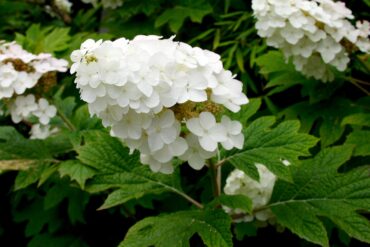
The best reason to grow hydrangeas in our region is that they bloom outside the spring season. After the magnificent, large rhododendron shrubs finish, most gardeners want to continue the flower extravaganza into summer and fall. Hydrangeas are one of the most popular shrubs to choose for this reason.
When you think about hydrangeas, your thoughts, most likely, are about the popular Hydrangea macrophylla with its large balls of flowers called mopheads. Lacecaps may also come to mind, yet many other types of hydrangeas fit into almost any kind of garden condition in this mild climate.
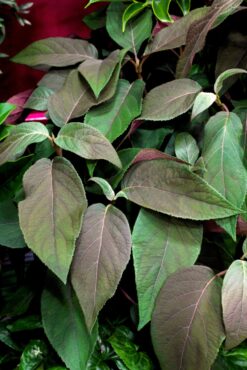
Hydrangea Aspera
Even though Ernest Wilson introduced the Chinese species in 1908, Hydrangea aspera was not that well known compared to others in this genus.
Once named outside the aspera umbrella as Hydrangea villosa, it’s now classified as H. aspera var. villosa. The hard-to-find H. sargentiana is now H. aspera var. sargentiana. When taxonomists melded them in as subspecies, H. aspera became better known as a hydrangea to love and grow.
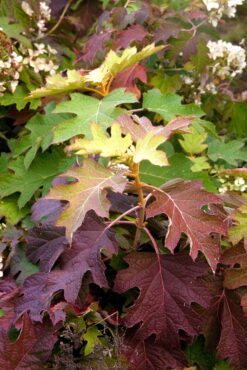
The species aspera is known for its foliage. It’s sought after by hydrangea enthusiasts for its large leaves, who consider the subspecies H. aspera var. sargentiana one of its best. This is not a small hydrangea. The leaves grow up to 1 foot in length and 8 inches wide. The shrub can grow to the height of a small tree. The lacecap blossoms consist of small, rosy, fertile flowers ringed by the larger, white-sepaled ray flowers.
A rounded shrub, Hydrangea aspera, with the tradename Plum Passion, is a selection of the species discovered in central China by Mikinori Ogisu. Dan Hinkley brought it back and introduced it through Monrovia Nursery.
White sepals surround the lavender fertile flowers, but this shrub is more about the foliage. The leaves open a greenish-purple hue and mature as dramatic deep purple, with rosy purple undersides. Imagine how dramatic it would look with a Clematis ‘Henryi’ climbing on this shrub. The clematis’ large, white flower would hold its own against the large, purple leaves.
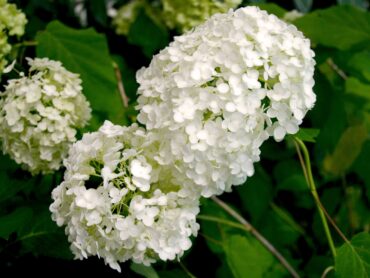
Hydrangea aspera species enjoy full sun to partial shade. Pest and disease-free, this is a carefree shrub.
Hydrangea Arborescens
Out of four native residents of North America, the following two hydrangea species reside in that region. Both grow in moist soil and are perfectly hardy in our climate. One of the easiest hydrangeas to grow is Hydrangea arborescens, commonly called smooth hydrangea. Its tree-like form gets up to 10 feet tall in the wild. The species has a small, white lacecap flower.
A sterile form of Hydrangea arborescens, ‘Annabelle’ has enormous heads of white flowers that first open in shades of lime and turn white as the blossoms mature. The heads are so heavy that when the shrub is young, it flops over from the weight. The shrub eventually grows substantial enough to hold its flowers up. The pest-resistant ‘Annabelle’ grows best in partial shade.
Since Hydrangea arborescens blooms on new wood, it can be cut to the ground early in the year. ‘Annabelle’ will grow 6 feet in one season and cover itself in white flowers. Left unpruned, tit will achieve a height of 10 by 5 feet.
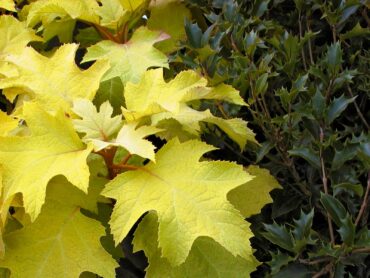
Hydrangea Quercifolia
Hydrangea quercifolia is another North American native to the eastern United States and is commonly called the oak-leaf hydrangea. The shrub is prized for its distinctive, oak-like leaves, with rich burgundy, red and orange hues in fall. The shrub’s flaky, tan and cinnamon bark and interesting scaffolding add exciting effects for the winter season. The shrub is equally at home in full sun or partial shade.
Briggs Nursery in Olympia has produced Hydrangea quercifolia ‘Little Honey’ that grows in gardens in the Northwest. Its small stature of up to 3 feet tall needs room to spread out to 6 feet wide. From England comes this sport of ‘Pee Wee,’ with soft yellow foliage, which adds more variation of foliage color in the border. It also gives another display of fall color later, when the weather cools down.
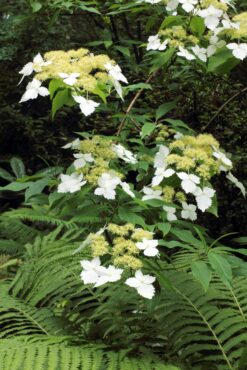
Hydrangea ‘Flemygea’ (trademark name Snow Queen) has a vast improvement of flowers, with more sterile flowers on 6- to 8-inch-long inflorescences. The sturdy stems hold the flowers upright, with no flop mops for this one, and reach 6 feet tall. Dark green leaves turn a red-bronze in fall.
Hydrangea Serrata and H. Angustipetala
The hydrangea story would not be complete without at least a brief mention of Hydrangea serrata and H. angustipetala.
Fragrance is a rare trait in the genus, yet Hydrangea angustipetala ‘MonLongShou’ has a sweet, Jasmine-like scent. The sterile serrated flowers on the lacecap flower look like stars. Blooming on both old and new wood, it’s best pruned right after it flowers. The shrub remains compact at 3 feet by 3 feet. The leaves are more like a willow and are deeply serrated.
Michael Dirr finds the plants and flowers of the species H. serrata “more refined than the ‘knock ’em dead’ Hydrangea macrophylla (mopheads) taxa.”
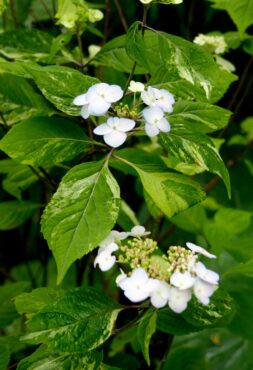
Out of the species serrata comes some fine cultivars including a variegated Japanese variety Hydrangea serrata ‘Matsu-Himo Nishiki,’ which roughly translates to pine, string, brocade. This is one of the smaller cultivars, topping out at 4 feet by 4 feet. Green and cream variegation makes it a standout in partially shaded woodland. Pretty, light blue, lacecap flowers come in June and July. Refined, indeed.
Hydrangea Care
Every species and cultivar listed are hardy in our region. Mostly found growing in woodlands, even though you can grow them in full sun, hydrangeas are best grown in partial shade.
None of the shrubs are completely drought-tolerant, even though some of the literature about them makes that claim. Add supplemental irrigation during the summer drought. They enjoy humus-rich, well-drained soil. Prune after flowering is finished, when necessary.




























Comments